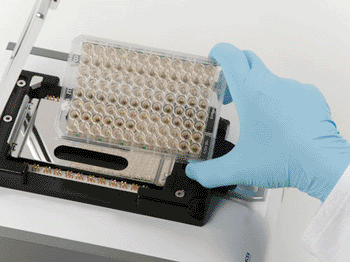Membrane-Based Microplate Inserts Allow Real-Time Studies of Cell-to-Cell Interactions and Communication
By LabMedica International staff writers
Posted on 26 Jun 2012
A novel membrane-based insert for 16-well and 96-well microplates enables life science researchers to study indirect cell-cell interactions and communication in real-time and without fluorescent labeling.Posted on 26 Jun 2012
The Roche (Basel, Switzerland) E-Plate Insert 16 and E-Plate Insert 96 were designed specifically for use with Roche’s line of xCELLigence Instruments.

Image: The E-Plate VIEW Insert 96 (Photo courtesy of Roche).
The xCELLigence System allows for real-time, label-free dynamic monitoring of cellular phenotypic changes by measuring electrical impedance. The system measures impedance using interdigitated microelectrodes integrated into the bottom of each well of special tissue culture E-Plates. Impedance measurements are displayed as Cell Index (CI) values, providing quantitative information about the biological status of the cells, including cell number, cell viability and cell morphology.
Electronic impedance of the microelectrodes is mainly determined by the ionic environment in the regions around the electrodes and can be monitored as baseline impedance by applying an electrical field to the electrodes. The presence of the cells will affect the local ionic environment at the electrode/solution interface, leading to an increase in the electrode impedance. The more cells there are on the electrodes, the larger the increases in electrode impedance. In addition, the impedance change depends on the quality of the cell interaction with the electrodes. For example, increased cell adhesion or spreading will lead to a larger change in electrode impedance. Thus, electrode impedance, which is displayed as cell index (CI) values, can be used to monitor cell viability, number, morphology, and adhesion degree in a number of cell-based assays.
CI was derived as a relative change in measured electrical impedance to represent cell status. This means that when cells are not present or are not well adhered on the electrodes, the CI is zero.
Under the same physiological conditions, when more cells are attached on the electrodes, then the CI values are larger. Thus, CI is a quantitative measure of cell number present in a well of the microplate. Additionally, change in a cell status, such as cell morphology, cell adhesion, or cell viability will lead to a change in CI.
In addition to monitoring cell viability, the xCELLigence System is able to identify culture wells with inappropriate cell numbers at the beginning of the assay, thus minimizing the role of cell seeding and culture plate-edge artifacts during data analysis.
The new E-Plate inserts allow co-cultivation of two different cell types, which is an important technique for investigating cell-cell interactions and communication. Investigators at INRS-Institut Armand-Frappier (Laval, Canada) used E-Plate Inserts to test the behavior of BeWo human placental choriocarcinoma cells in co-culture with H295R human adrenocortical carcinoma cells.
“Using the E-Plate Insert in our co-culture experiments requires fewer manipulations and allows us to perform several experiments simultaneously - hormone measurements, signaling pathway analysis, real-time monitoring of biochemical and morphological differentiation of the cells,” said Dr. Thomas Sanderson, associate professor of toxicology at INRS-Institut Armand-Frappier .
Related Links:
INRS-Institut Armand-Frappier
Roche










 (3) (1).png)


